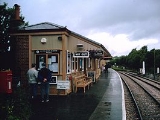
Toller railway station
Encyclopedia
Toller was a railway station on the Bridport Railway in the west of the English
county of Dorset
. The station served the village of Toller Porcorum
. Opened on 31 March 1862, five years after the branch, it consisted of a single platform and modest wooden building.
, it was placed in the Western Region
when the railways were nationalised in 1948.
The branch was threatened with closure in the Beeching
report, but narrow roads in the area, unsuitable for buses, kept it open until 5 May 1975. In its final years, trains were normally formed of a single carriage Class 122
diesel railcar.
on the South Devon Railway
, a heritage linehttp://www.southdevonrailway.org/News-and-Press-Releases/Littlehempston_Award.html.
England
England is a country that is part of the United Kingdom. It shares land borders with Scotland to the north and Wales to the west; the Irish Sea is to the north west, the Celtic Sea to the south west, with the North Sea to the east and the English Channel to the south separating it from continental...
county of Dorset
Dorset
Dorset , is a county in South West England on the English Channel coast. The county town is Dorchester which is situated in the south. The Hampshire towns of Bournemouth and Christchurch joined the county with the reorganisation of local government in 1974...
. The station served the village of Toller Porcorum
Toller Porcorum
Toller Porcorum is a village and civil parish in West Dorset, England, situated in the Toller valley ten miles north west of Dorchester. The village has a population of 292 ....
. Opened on 31 March 1862, five years after the branch, it consisted of a single platform and modest wooden building.
History
Opened by the Bridport Railway, but operated from the outset by the Great Western RailwayGreat Western Railway
The Great Western Railway was a British railway company that linked London with the south-west and west of England and most of Wales. It was founded in 1833, received its enabling Act of Parliament in 1835 and ran its first trains in 1838...
, it was placed in the Western Region
Western Region of British Railways
The Western Region was a region of British Railways from 1948. The region ceased to be an operating unit in its own right in the 1980s and was wound up at the end of 1992...
when the railways were nationalised in 1948.
The branch was threatened with closure in the Beeching
Beeching Axe
The Beeching Axe or the Beeching Cuts are informal names for the British Government's attempt in the 1960s to reduce the cost of running British Railways, the nationalised railway system in the United Kingdom. The name is that of the main author of The Reshaping of British Railways, Dr Richard...
report, but narrow roads in the area, unsuitable for buses, kept it open until 5 May 1975. In its final years, trains were normally formed of a single carriage Class 122
British Rail Class 122
The British Rail Class 122 diesel mechanical multiple units were built by Gloucester RC&W in 1958. Twenty single-car driving motor vehicles, called "Bubble Cars", were built, numbered 55000–55019...
diesel railcar.
The site today
The platform can still be seen from the overbridge although the building was moved to LittlehempstonTotnes (Littlehempston) railway station
Totnes station, previously known as Totnes Riverside station and Littlehempston Riverside station, is a railway station situated in Littlehempston in the English county of Devon. It is the southern terminus of the South Devon Railway, a steam operated heritage railway...
on the South Devon Railway
South Devon Railway Trust
The South Devon Railway Trust is a charitable organisation that operates a heritage railway from Totnes to Buckfastleigh in Devon, alongside the River Dart...
, a heritage linehttp://www.southdevonrailway.org/News-and-Press-Releases/Littlehempston_Award.html.

